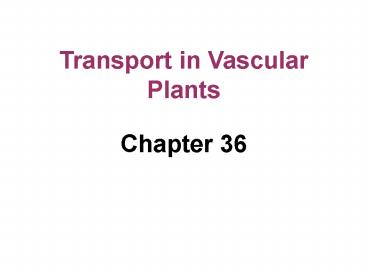Transport in Vascular Plants - PowerPoint PPT Presentation
Title: Transport in Vascular Plants
1
Chapter 36
- Transport in Vascular Plants
2
- Physical forces drive the transport of materials
in plants over a range of distances - Transport in vascular plants occurs on three
scales - Transport of water and solutes by individual
cells, such as root hairs - Short-distance transport of substances from cell
to cell at the levels of tissues and organs - Long-distance transport within xylem and phloem
at the level of the whole plant
3
- A variety of physical processes
- Are involved in the different types of transport
CO2
O2
Light
H2O
Sugar
Sugars are transported as phloem sap to
roots and other parts of the plant.
O2
H2O
CO2
Minerals
Figure 36.2
4
Selective Permeability of Membranes A Review
- The selective permeability of a plant cells
plasma membrane controls the movement of solutes
into and out of the cell - Specific transport proteins enable plant cells to
maintain an internal environment different from
their surroundings
5
The Central Role of Proton Pumps
- Proton pumps in plant cells
- Create a hydrogen ion gradient that is a form of
potential energy that can be harnessed to do work - Contribute to a voltage known as a membrane
potential
Figure 36.3
6
- In the mechanism called cotransport
- A transport protein couples the passage of one
solute to the passage of another
7
- The effect of cotransport is also responsible for
the uptake of the sugar sucrose by plant cells
8
- Water Potential
- Is a measurement that combines the effects of
solute potential and pressure potential - Determines the direction of movement of water
- Water flows from regions of high water potential
to regions of low water potential
9
- How Solutes and Pressure Affect Water Potential
- The solute potential of a solution
- Is proportional to the number of dissolved
molecules - Pressure Potential
- Is the physical pressure on a solution
10
- The addition of solutes reduces water potential
Figure 36.5a
11
- Application of physical pressure increases water
potential
Figure 36.5b, c
12
- Negative pressure
- Decreases water potential
Figure 36.5d
13
- Water potential
- Affects uptake and loss of water
- by plant cells
- If a flaccid cell is placed in an
- environment with a higher solute
- concentration the cell will lose
- water and become plasmolyzed
14
- If the same flaccid cell is placed in a solution
with a lower solute concentration the cell will
gain water and become turgid
15
- Turgor loss in plants causes wilting which can be
reversed when the plant is watered
Figure 36.7
16
Compartments of Plant Cells and Tissues and Three
Routes for Short-Distance Transport
17
Lateral Transport of Minerals and Water in Roots
18
The Fungal Hyphae of Mycorrhizae Increase the
Absorption of Water and Minerals
19
Aquaporin Proteins and Water Transport
- Aquaporins
- Are transport proteins in the cell membrane that
allow the passage of water - Do not affect water potential
20
- The plasma membrane
- Directly controls the traffic of molecules into
and out of the protoplast - Is a barrier between two major compartments, the
cell wall and the cytosol
21
- Water and Minerals Ascend From
- Roots to Shoots Through the Xylem
22
- Transpiration produces negative pressure
(tension) in the leaf which draws water out of
the xylem into the mesophyll
23
The Generation of Transpirational Pull in a Leaf
24
Ascent of Water in a Tree
25
The Mechanism of Stomatal Opening and Closing
26
The Diffusion of K Ions Into and Out ofthe Guard
Cells Opens and Closes the Stomata
27
An open (left) and closed (right) stoma of a
spider plant (Chlorophytum colosum) leaf
28
- Review
- As water ascends up a tree water
- potential decreases/increases.
- 2) A beaker of pure water open to the
- atmosphere has a water potential of . . . A
flaccid cell placed in this solution would become
. . .
29
3) A turgid cell is placed into a solution with
a high solute concentration. The pres- sure
remains unchanged. What happens to water
potential inside the cell? 4) Discuss the
movement of K ions in guard cells that would
occur during a 24 hour period on a typical hot
summer day.































